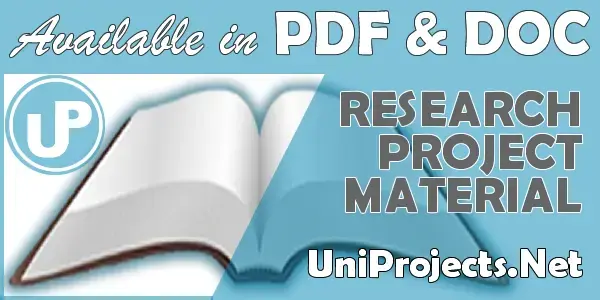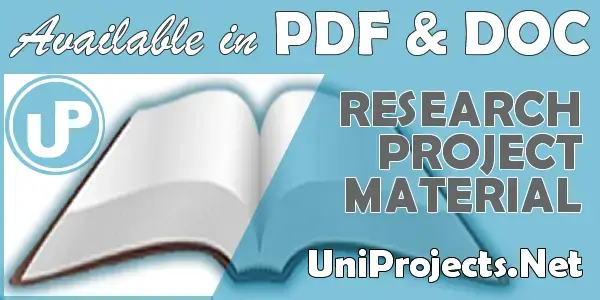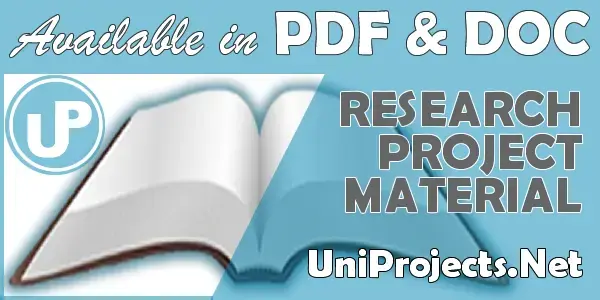Design And Implementation Of A Web Based Repository For Undergraduate Projects
Chapter One
INTRODUCTION
1.1 Background to the Study
Storage facilities may hold aggregations of learning things as a circulation focus may store books, or they could hold collections of information about learning articles as a library record may hold portrayals about books. Storage facilities offer parts to bolster the disclosure, exchange and re-usage of learning articles (Richards, McGreal and Friesen, 2002).
The School of Information and Communication Technology (SICT) repository, Federal University of Technology (FUT) Minna is an online application with a user friendly interface that will provide access for a user to easily lay hands on all the undergraduate projects written by graduates of SICT. The information provided about a project is majorly the project abstract and a hand full of other relevant pieces of information such as the student name, the year of project submission (the year the project was written) and the project topic.
This repository will provide a user the ability to browse the project catalog and search through by the student name, project topic or year of project submission. Hence, this will help potential graduates of the faculty (SICT) to know the topics that research has been carried out on, the area of concentration of the research done and the extent to which the researcher stopped.
1.2 Statement of the Problem
Projects already submitted to the SICT cannot be accessed anywhere and at anytime without having to come to the school building and reaching the office in charge. In case of fire incidence or water, the copies of the projects curated by the school could be damaged or totally lost. Searching of projects is very hectic and slow due to the quantity of projects and limited human effort. Also, access to projects can be delayed due to the official procedures and protocols involved in the process.
Therefore, this work is to develop a repository to solve this problem.
1.3 Aim-and-Objectives-of-the-Study
The purpose of this study is to develop a web-based repository for undergraduate projects of SICT, FUT Minna. This will be achieved by the following objectives:
i. To design a web-based repository for undergraduate for SICT, FUT, Minna.
ii. To implement the design in (i) using PHP and MySQL.
iii. To evaluate the proposed system in (i).
1.4 Significance of the Study
A key function of this research is that the SICT repository provides a unique storage identifier for every object, therefore making it feasible with the aid of the search module incorporation into the web-based repository application to efficiently search, discover and retrieve objects (projects) from its database. Both staff and student will benefit from this feature in that one can easily search for a project by the project name, student name or year. The office in charge of keeping and handling undergraduate projects will now have better support for storage of graduates’ projects and easy retrieval on request.
The SICT repository could also serve as an educational environment for many internet users and researchers. It will encourage researchers to take up further research on a subject matter (like a project) and thereby add to the body of knowledge. This repository also covers authors of the projects and because it clearly attributes the student name (author) to its content.
1.5 Scope and Limitation of Study
This study only takes undergraduate projects of the SICT of Federal University of Technology Minna into regard. A single material (like a project) will contain only the project topic, student name, abstract and the year of project submission.
A user will only be able to search the project catalog for a project either by the project topic, student name, keyword and year of submission.
The SICT repository will be only accessible online (for instance, with an active internet connection and with the aid of a browser) and cannot be accessed offline, except when installed on a computer with an active server application and a MySQL database application. Projects cannot be downloaded for offline usage or access.
1.6 Definition of Terms
Learning Objects: In the context of this research, a learning-object-is-a-resource with a clear educational-application. It is in digital form – examples: a Microsoft Word Document or a PDF document.
Catalog: This research applies the word ‘catalog’ as a container that presents all the SICT projects logged/stored in an organized tabular format, showing relevant information about each project. It can be compared to a library catalog containing all the information about books – their titles, author, number of pages, published year, ISBN etc.
Repository: A repository (in this case; SICT repository) is an archive, storehouse or container that allows storage, cataloging, accessing all SICT undergraduate projects and thesis, and viewing each object’s content.
Identifier: An identifier is simply a unique identity attached to one object, it aids referencing such object directly when its identifier is requested. An identifier can be a serial number, identity number (also written as ‘ID’) or an index number.
Object: An object in the context of this research refers to a project record returned by a database – queried using an Object Oriented Programming (OOP) approach. An object (i.e. a project record) returns or contains the project topic, student name, abstract, year of project submission and the date and time the object record was created.
Database: A database is a repository that allows storage, retrieval and manipulation of data. A database can be used efficiently with the aid of a Database Management System (DBMS) – a set of tools that allow storage, access, retrieval and maintenance of data stored in a database, examples of DBMS include XAMPP, WAMP, LAMP and AppServ to mention a few. A database understands only the Structured Query Language (SQL) which is used to communicate with it, popular databases used by well-known Information Technology (IT) firms include are MySQL, Oracle and Django DB.
Web-Browser: A web-browser,-internet-browser-or-browser-is-software program that interprets the codes written in markup languages in graphic and visual (like images, text, audio or animation) form. This allows users to easily request and access a website or to search for information through a search engine (either Google, Ask, Bing and AOL among others).
Keyword: A phrase or just one word that is used to search for a certain result or set of results.
User: A user is system, application, request or person that can use a computer or software to perform a specific task.
Metadata: A set of data that describes and gives information about other data.
Dataset: A collection of related game plans of information that is made out of disengaged segments however can be controlled as a unit by a PC.
Relational Database: A database composed to see association among relations of information delineates tables from which data can be gotten to or reassembled in different courses without rearranging the database tables.
Chapter Two: Literature Review
2.0 INTRODUCTION:
This chapter provides the background and context of the research problems, reviews the existing literature on the Design And Implementation Of A Web Based Repository For Undergraduate Projects, and acknowledges the contributions of scholars who have previously conducted similar research [REV45466] …








